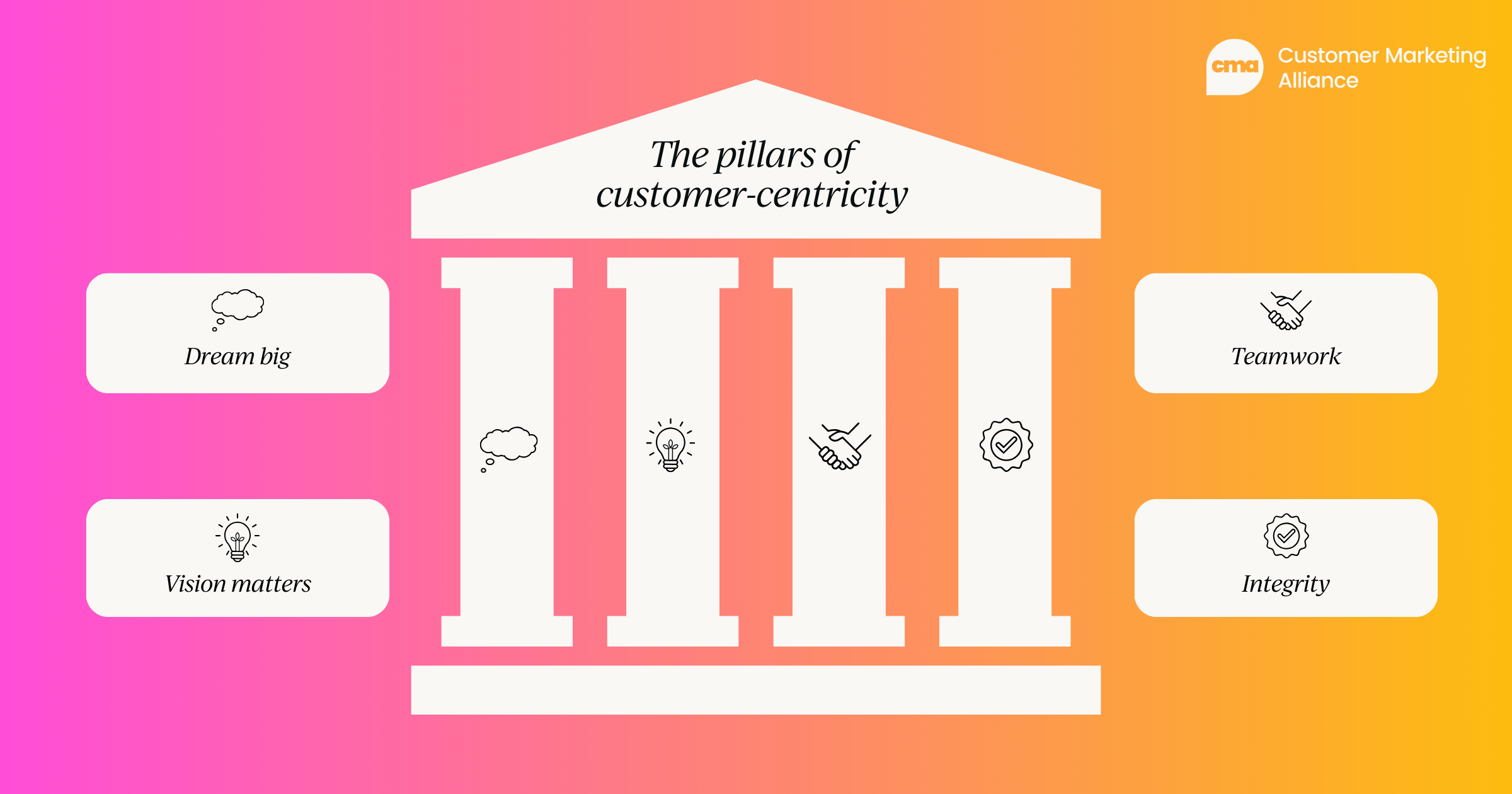When it comes to customer advocacy and community engagement, there’s one thing we know for certain: strong relationships drive success.
Advocacy isn’t about pushing marketing agendas – it’s about creating an environment where customers feel valued, heard, and empowered.
The central thread to all conversations around advocacy and engagement is this: authenticity matters. Advocacy programs thrive when they are built on genuine relationships, transparency, and a true desire to support and uplift customers.
If you’re looking for insights on how to create a thriving customer community, you’re in the right place. In this article, we explore:
- If there’s a difference between customer advocacy and customer marketing
- How to create a customer-first mentality
- What it means to give customers a seat at the table
- The key takeaways for building an impactful advocacy program
Customer advocacy vs. customer marketing
One of the most common discussions we hear around advocacy programs is the distinction between customer advocacy and customer marketing – and whether you can have one without the other.
It’s a question that comes up frequently, and for what its worth, we ought to interrogate the relationship between the two.
At its core, customer marketing is a natural byproduct of a well-executed advocacy program, but the reverse is not always, if ever, true.
This goes back to a fundamental truth: people don’t like being sold to. It’s an unnatural feeling, when you realize you’re being marketed to.
However, when you treat customers well, invest in their success, and build meaningful relationships through advocacy, something powerful happens – they become organically inclined to support your marketing efforts.
They see value in the program, they trust your organization, and they want to be a part of the journey. If you build a program to gave back to your customers, you'll always be able to fulfill your marketing team’s requests. When you provide value to them, and you’e a strategic part of their success, there are always going to be customers that are willing to do stuff on your behalf.
We’ve tried this before and here’s the verdict: Leading with asking and then giving back further down the funnel doesn’t always work.
Advocacy should never be about extraction – about taking testimonials, case studies, or references from customers without first building a foundation of trust and value. Instead, it’s about creating an ecosystem of mutual benefit.
The importance of making advocates comfortable
Another misconception is that customers are always ready and willing to speak on behalf of a company. That’s not the case. Customers have different levels of comfort when it comes to engaging in advocacy, and as community leaders, it’s our job to understand where they feel most at ease.
Are they comfortable speaking at events? Are they comfortable speaking on webinars? Are they comfortable speaking to prospects? Having that information also helps us identify where we can safely place them in customer marketing.
This is a critical step in building a successful advocacy program. Not every advocate wants to be on stage at a conference.
Some may prefer writing a blog post, participating in a closed-door customer advisory board, or sharing feedback in a one-on-one setting.
When we take the time to truly understand our advocates – what excites them, what makes them nervous, and where they can shine – we create experiences that are beneficial for both them and our organizations.
Ultimately, advocacy and marketing can work hand in hand, but the best results happen when we lead with advocacy and let marketing follow naturally. If we focus on providing value, building trust, and making advocacy an enjoyable experience, the marketing side of things will take care of itself.
How to create a customer-first mentality
All stellar community leaders know the importance of creating a customer-first space, but I don’t always get the sense that everyone understands how to do it effectively.
It’s one thing to say customers come first; it’s another to build programs and cultures that actively reflect that belief.
Creating a customer-first mentality has to come from both a program perspective and a personal perspective.
From a program perspective, this means being intentional about the pillars that shape the experience you’re creating.
Here are some critical questions that help guide this process:
- What do you want to give back to your customers?
- What internal goals do you need to hit?
- What are the goals that need to be met across all stakeholders?
Internal buy-in is essential across the board. Every single business unit needs a hand in the pot. Whether it’s engineering support, product management, product marketing, or customer experience, if everybody is not on board, that will create roadblocks and prevent your community from thriving.
Customer advocacy can’t exist in a silo. If different teams within an organization don’t understand or support the mission of an advocacy program, it can lead to major roadblocks.
That’s why a customer-first approach needs to be woven into the fabric of the company, not just something left to the advocacy team alone.
But beyond the program itself, creating a customer-first mentality is also deeply personal.
The pillars of customer-centricity

Your personal pillar should always be to dream big. To always dream big. When you’re pitching a program, whether it’s internally to somebody who’s heard it ten times before or to somebody new, you should always aim to be confident in the vision of where you want to go.
Vision matters. As advocacy leaders, we need to be willing to take bold risks, make tough decisions, and take full ownership of the communities we build. Whatever touches your community, own it. You’re accountable for it. Don’t try and pass the buck to your community lead.
Another key pillar is teamwork. The best advocacy programs don’t function in isolation. They thrive on collaboration – finding ways to connect with any department or individual who can bring value to customers.
And at the heart of everything is integrity. Always try to conduct yourself with honesty and integrity with every single customer and in every single interaction. It’s not always easy – sometimes, you’ll want to tell them more than you can, but leading with as much transparency as possible earns their respect on a level that is absolutely stellar.
Ultimately, you have to love what you do. If you’re not passionate about advocacy, if you don’t genuinely care about your customers, they’ll know. And if they sense that enthusiasm and authenticity, they’ll respond in kind.
Having well-defined pillars also allows you to be a human. The human aspect of these communities is so important. Wewould also stake our jobs that robotic communities do not thrive.
Because at the end of the day, customer advocacy isn’t just about strategy – it’s about relationships. It’s about showing up, being accountable, and creating spaces where customers feel valued, supported, and empowered. When you build from that foundation, success follows naturally.
What does it mean to give your customers a seat at the table?
At the heart of any great customer advocacy program is the commitment to giving customers a seat at the table – creating opportunities for them to connect with each other and with your organization in meaningful ways.
But what does it really mean to put customers at the center of decision-making? It comes down to something simple, yet powerful: The seat at the table concept means listening, which isn’t rocket science, right? But in order to do it well, you have to be willing to put your ear to the ground and hear what your customers want and need.
Listening sounds obvious, but listening well is an entirely different skill. It means going beyond surveys and feedback forms – it’s about actively seeking out customer insights and using them to shape the direction of your programs and initiatives.
Listening means being willing to pivot
Sometimes, what customers need isn’t what’s on your organization’s roadmap. But at the end of the day, our product isn’t just what our teams are building – it’s the people we serve. Their needs, expectations, and challenges evolve constantly, and we have to be willing to adjust.
You may find yourself with an entire plan mapped out for an advocacy program. Then suddenly, your customers aren’t looking for the same things. Instead of structured initiatives, they wanted connection.
But it’s all about being adaptable. Like many during COVID-19, Jamf’s advocacy programs pivoted to virtual meetups, many of which may still continue to this day. For example, Jamf routinely gets 50 to 60 customers from up to 11 different countries on those calls, with friendships developing constantly.
That was a simple shift – one that took very little effort to implement – but it made a world of difference. Those meetups became a source of support and community for Jamf’s customers, and they continue to be a core part of its advocacy program today.
Amplifying customer voices in meaningful ways
There are many ways to ensure customers feel heard. One of the simplest is asking for feedback regularly – and actually acting on it.
Another approach is to involve them in key initiatives, such as:
- Focus groups to gather real-time insights
- Beta testing to give them early access and a sense of ownership
- Customer advisory boards to provide strategic input on product and service direction
Beyond that, amplifying customer voices within your organization is just as important. Taking the incredible ideas and experiences of our customers and making sure they’re heard in the right places.
One of the most effective ways to do this is through content creation. Customers can share their insights by writing blog posts for your organization’s website, giving them a platform to highlight their expertise.
You should also make it a point to share customer stories internally – whether it’s through Slack, all-company meetings, or leadership briefings. If you hear something great in your program, whether it’s a customer success story or feedback on our support team, do make sure the right people know about it.
When we consistently amplify customer perspectives, we create a culture that truly values them – not just as users of our products, but as partners in shaping the future of our business.
At the end of the day, giving customers a seat at the table is about respect, inclusion, and action. If we listen, amplify, and adapt, we create advocacy programs that don’t just engage customers, but empower them.
Tips and tricks for success
There are countless strategies and best practices for building a strong customer advocacy program, but at the end of the day, it comes down to something simple: building real, human relationships.
One of the most important things we’ve learned along the way is that vulnerability matters. Community and advocacy leaders often feel pressure to always have the answers, to be the steady presence for our customers. But sometimes, the most impactful thing we can do is show up as our authentic, imperfect selves.
A case study in vulnerability
One of the most important things we've learned along the way in our roles is that vulnerability matters. As community and advocacy leaders, we often feel pressure to always have the answers, to be the steady presence for our customers. But sometimes, the most impactful thing we can do is show up as our authentic, imperfect selves.
During a virtual meetup at Jamf, customers were opening up about their struggles, and this had a profound effect.
Jennifer felt compelled to share that moment of raw humanity with her customers. She recorded a short message saying:
"I just woke up from an awful nightmare, and I think it's because the world is crazy. We're all going through so much, so if this is any help or enjoyment to you, I'm going to deliver something that makes me feel better."
Then, she sang a few verses of a well-known comfort song and sent it to them.
The responses were overwhelming. People told her how much it meant to hear that someone else was experiencing the same struggles – that she had taken the time to be real with them.
This experience reminds us that little gestures matter. We often think about big, strategic initiatives, but sometimes the most powerful impact comes from small, thoughtful actions.
Things like:
- Sending handwritten thank-you notes
- Congratulating a customer on a life milestone (a new baby, a work anniversary, a promotion)
- Recognizing their achievements publicly within the company
These aren’t just transactional moves – they are ways to build genuine relationships. And if nothing else, that’s what advocacy is all about. If we truly want to know our customers, want to help them, and want to celebrate them, we’re going to be successful.
Personalize your advocacy programs
Personalizing everywhere and anywhere that you can is really great. Even if it means sending 50 emails as opposed to one email, that personalization – speaking directly to that one customer – could be the difference between success and failure.
It’s not just about sending out mass communications – it’s about speaking directly to individuals in a way that resonates.
Never forget empathy
Another key piece? Empathy.
If they need you and they’re reaching out, there’s probably a reason for that. So take a step back, no matter how busy you are, and put yourself in your customer’s shoes. Taking the time to understand a customer’s unique needs, frustrations, and goals can transform how they engage with your advocacy program.
Never underestimate the power of creativity and fun
Customers get excited when they know they’re your guinea pig. Do something fun with your customers. Take the mundane task of doing something on our behalf and put some spice into it.
One of Jennifer’s most successful engagement posts happened back in 2018. The prompt?
“Take a movie title and replace one of the words with ‘bacon.’”
Years later, that post still gets engagement. It’s a reminder that sometimes, the simplest ideas – ones that spark joy and laughter – are the most effective.
At the end of the day, advocacy is about connection. People want to feel valued, seen, and appreciated. When we lead with empathy, authenticity, and creativity, we don’t just create engaged communities – we build lasting relationships.
We hope everyone reading this has found a few takeaways to apply in their own programs. Customer advocacy is an exciting space, and we can’t wait to see how it continues to evolve.





